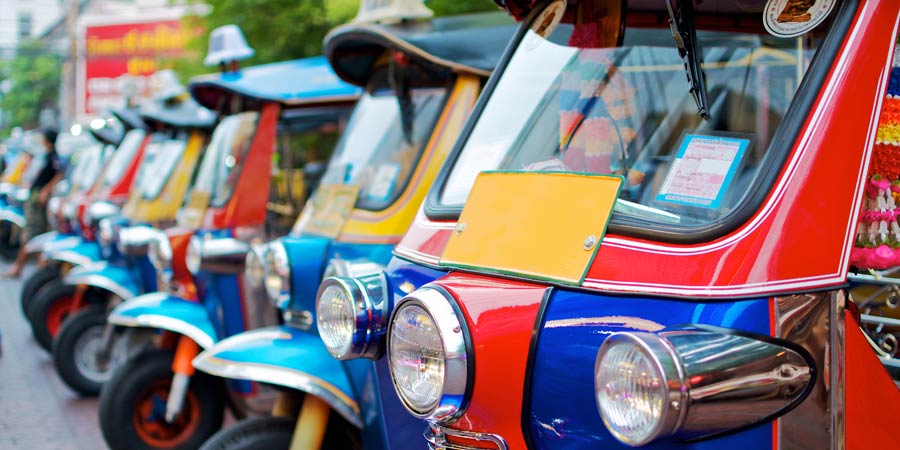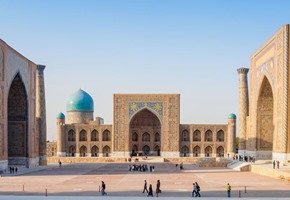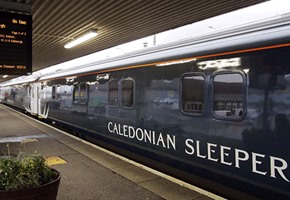How about that latest episode of Tony Robinson's Around the World by Train? He was off to the marvellous cities and beautiful beaches of Thailand and Malaysia, stopping off at some pretty stunning destinations.
Thailand is one of those incredible places which does everything with so much gusto. Sure, everyone knows the whirlwind of human activity in Bangkok and the turquoise waters of the Phi Phi Islands, but this is just a tiny snapshot of the gorgeous natural and man-made sights available across this area of Southeast Asia. Gold-domed Buddhist temples rising against the sky, crisp, white-sand beaches tucked into jungle bays and ancient mountains painted in emerald green; it's small wonder this was Tony's next destination.
Travelling through Bangkok and Penang through the 'Land of the Free' as Thailand is known, Tony reminds us that Thailand was the only country in Southeast Asia never to be colonised by Europeans. Stopping off in the Changmai area of Thailand, Tony visits a Buddhist temple just in time for a spectacular ceremony which sees Buddhist monks descending into the town just as the Buddha did in religious tales. Continuing on his way, he visits some of Thailand's most impressive residents, the wonderful Asian elephant. After seeing some adorable elephants, including an overly friendly calf, Tony takes part in a new and rather pungent form of elephant tourism, involving a shovel and droppings.
Later, he hops onto a 13-hour sleeper train, featuring communal bunks. It looks pretty swanky, with its transforming bunks and multi-level meals, which he takes full advantage of on his way through to the bustling capital of Bangkok. Arriving to the sound of the national anthem, Tony embarks on a ride on one of Thailand's famous tuk tuks, a tiny motorbike style vehicle with a small cabin in the back, sampling some of Thailand's famous street food along the way. Chomping down on a silk worm ('challenging and not filling') with his amiable tuk tuk driver (with the excellent name of King Kong), Tony then continues to the remarkable canals of Bangkok on his food tour, trying some of the charming bites found on the many market boats which float along the river.
The two then continue, via tuk tuk of course, to the grounds of another temple for a visit to the national school of Thai massage. Here he sits down, or rather, lies down to a particularly indulgent Thai massage, which Tony tells us is more like yoga. The art is three thousand years old, according to the masseuse, invented as it was, by a Thai doctor. Feeling relaxed, they head through the sparkling lights of the Bangkok so Tony can catch his next train. He bids goodbye to faithful King Kong at the station.
This one takes 16 hours, travelling along the glorious southern Thai coast to the rather more laid-back city of Trang. Here we get a taste of the Thai islands, as Tony joins Sang, a local fisherman, on his boat. The two glide across the waters, under the gaze of the surrounding mountains, to the rather fascinating-looking emerald cave where the two and the whole team, leap into the wonderful colours of the Thai ocean. In what looks like a rather special excursion, Sang and Tony swim through an underwater passage, through schools of fish and in utter darkness, to emerge on their own private beach, isolated from the rest of the world. It looks spectacular, as they stand under the blue sky in a natural courtyard. The peace and solitude is somewhat broken by the emergence of other tourists, but the moment is still a rather striking one. Finally, The pair continue to Sang's own village, where they attend a barbecue, cooking some of the fish which frequent the islands. The scene looks utterly idyllic, a beachside paradise made for a friendly community who combine traditional industry with more modern tourism which Thailand has come to be known for.
Tony bids a fond farewell to Thailand, crossing over to Malaysia for a very different kind of Southeast Asian experience, one heavily influenced by British colonial rule. Indeed, the very first station he stops off at is named Butterworth after a former pompous British governor - a far cry from the exotic names of Thailand. He the crosses the straits of Malacca to Penang Island, formerly a British colony, and stops off in area of Georgetown which is a UNESCO World Heritage site. Tony walks along a wholesome street known as the 'street of harmony', home to no fewer than four major religious centres. He also stops off at a Chinese incense shop to sample a negative-thoughts-expelling incense and to meet a ninety-year-old joss stick maker.
After sampling some aromatic durian fruit, Tony heads up a funicular railway, built in 1923 by British imperialists, to marvellous Penang Hill. Some stunning views of the Malaysian rainforests greet him at the top, and he meets with a rainforest specialist to learn a bit more about this incredible natural region and the colourful wildlife hidden in the canopies above. He also makes the daring ascent up a tree, using ropes to climb above the rainforest ceiling for an even more magnificent panorama over the carpet of green which stretches right up to the ocean.
Tony's final stop takes him down the Malaysian coast on an electric train service from Butterworth to the glittering skyline of Kuala Lumpur, the capital city and one which is split into enormous skyscrapers and smaller traditional town houses. Tony takes a quick tour, finding out about the city's history of British colonial oppression and the two halves of this enigmatic city. Him and his guide hear the Muslim call to prayer from atop one of the glass towers, and see night fall on the electric stars of Kula Lumpur - a fitting end to Tony's Southeast Asia experience.




